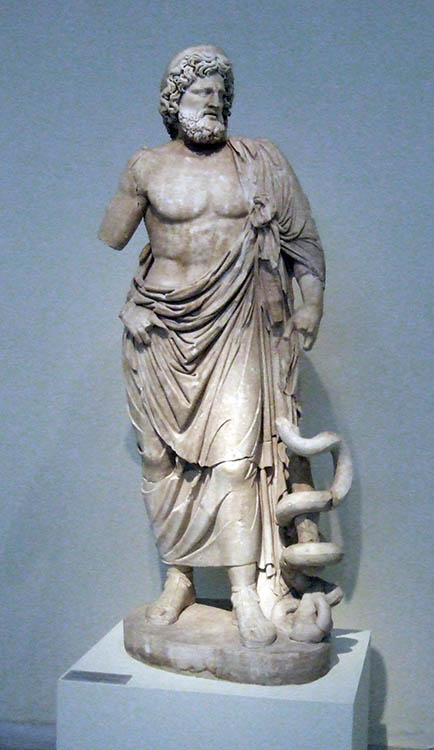In the fifth century BC the cult of Asclepius began to blossom. There is a lot of mystery surrounding this transitional moment; what is certain is that by the early 4th century, the sanctuary of Asclepius at Epidaurus was panhellenic in nature. Asclepius and his cures drew attention from around the Mediterranean basin.
The reputation of the cult spread to such an extent that Epidaurus was considered a premier destination for healthcare at the time.
The epicenter of the cult of Asclepius remained at Epidaurus for centuries, and one of the most magnificent and daring buildings at this site was the unique and mysterious Thymele.
Asclepius the Myth
Asclepius’ father Apollo rescued his unborn son from the funeral pyre of his mother Coronis and entrusted him to the Centaur Chiron, who raised him and taught him the art of medicine.
Asclepius the God
As Asclepius grew more and more proficient in the practice of medicine, he began to save individuals from death and even resurrect some who had died. His grandfather Zeus, anxious to preserve his own supremacy among the gods, grew angry at this transgressive act and sent Asclepius to Hades with a thunderbolt.
Apollo managed to convince his father to bring Asclepius back from Hades and eventually he received full divine status, residing forever among the gods.
Asclepius the Cult
 Asclepius was worshipped all over Greece and far beyond, from Hispania in the west to Ecbatana in the east, from Britain in the north to Libya in the south. Often his sanctuaries were built just outside of towns, in places where patients could benefit from therapeutic breezes and good sources of water for drinking and
bathing. His sanctuaries were places of worship that were visited by great numbers of sick people.
Asclepius was worshipped all over Greece and far beyond, from Hispania in the west to Ecbatana in the east, from Britain in the north to Libya in the south. Often his sanctuaries were built just outside of towns, in places where patients could benefit from therapeutic breezes and good sources of water for drinking and
bathing. His sanctuaries were places of worship that were visited by great numbers of sick people.
The principal seat of his worship in Greece was at Epidaurus, where his mega-sanctuary offered facilities for worship and therapy that included temples, altars, performance venues for music and drama, athletic facilities, baths, hotels, dining areas, and the enigmatic round Thymele.
A famous statue of Asclepius at Epidaurus, decorated in ivory and gold, was created by the great artist Thrasymedes. It depicted the god as a handsome, bearded figure, similar to Zeus, sitting on a throne and holding
a staff, with one hand resting on the head of a serpent, while a dog lies at his side.
Serpents were a symbol of renewal, believed to have the power of discovering healing herbs and to be guardians of wells with salutary powers.
The sick, who visited the temples of Asclepius, underwent a series of preliminary rituals before sleeping in the sanctuary, such as bathing and offering sacrifices. If Asclepius chose to do so, he would appear to his worshippers in a dream, proposing or implementing remedies.
The cured thanked the god for his help, often by dedicating a votive tablet depicting the healing event or the part of the body that was cured. The sanctuary at Epidaurus, as well as those at Lebana on Crete and at Rome, also contain many inscriptions that record the names of patients, their disorders, and the nature
of their cures. These were published
on large stone placards that stood in the center of the sanctuary, serving as both an inventory of the god’s cures and an advertisement of his miraculous powers.
Many sanctuaries of Asclepius around the Mediterranean world were offshoots of the sanctuary at Epidaurus. For instance, the cult of Asclepius was
introduced to Rome from Epidaurus at the command of the Sibylline books in 293 BC in order to avert a pestilence.
Homer on Asclepius
The earliest known appearance of Asclepius in Greek literature is in Homer's Iliad. A war epic, the Iliad does not shy away from the violence of war. Full of graphic details, Homer's poem celebrates the skills of men specially trained to heal difficult battle wounds. Among these trained healers is Asclepius, described as a “blameless physician” and as the father of two other skilled physicians, Machaon and Podaleirius.
Descendants and Students
The descendants of Asclepius were called by the patronymic Asclepiadae. Originally, medical knowledge was transmitted from father to son in the families of the Asclepiadae. Later, non physicians were apprenticed to healing families.


